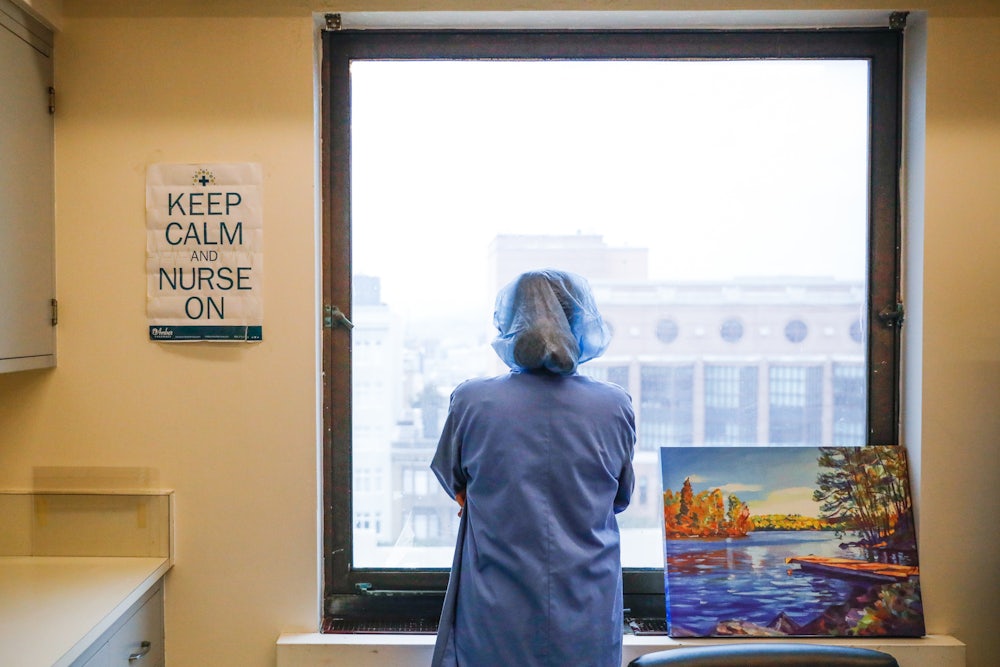Last year, a 28-year-old E.R. nurse named Tristin Smith took her own life. Her father found a note among her effects, titled Letter to My Abuser. “Ever since I was young, I expressed interest in healthcare,” she wrote. “I gave my heart, my body, and my mind to you.” But as “unnecessary” support staff was cut, the quality of care plummeted. Requests for more resources were met with online training sessions telling nurses “to just smile more and be friendlier to patients.” Instead of receiving the “support we deserve, we get a pizza party and free pens for the ‘healthcare heroes.’” Her disillusionment deepened: “You use and exploit us to line your pockets, using the common citizen’s money for overpriced healthcare.”
For me, as an emergency physician, Tristin’s words ring with startling clarity. I know firsthand the challenges of constantly doing more with less. I recognize the surreal disorientation of having real needs met with empty gestures, like free pens or a hospital potato. I have felt that the systems in which I work no longer value me, or the patients whom I treat. But the most astute aspect of Tristin’s letter is the culprit she points to for these problems: an obscenely expensive health care system that values profit above all else, to the detriment of patients and providers alike.
We in the medical profession are all, to varying degrees, like Tristin. A survey of over 12,000 physicians released last month by the American Medical Association found that 48 percent of them had at least one symptom of burnout. Another survey last month found that nearly two-thirds of physicians would not recommend a career in medicine to their children. It’s not just physicians, of course: Health care providers of all kinds are burned out and considering leaving their jobs. “That’s a disaster for a system that is already struggling to fill critical roles,” said L. Casey Chosewood, an official at the National Institute for Occupational Safety and Health, NIOSH.
This is a massive problem not only for our health care system but for every single person in America who depends on it. Burnout is associated with medical errors and malpractice litigation; hospital-acquired infections; and anxiety, depression, and suicidality among providers. Physicians with burnout are twice as likely to leave their jobs and five times more likely to quit medicine entirely, at an annual cost as high as $6 billion. For nurses, the annual cost of turnover related to burnout is estimated at $9 billion.
The pandemic clearly made burnout worse, for obvious reasons. But things aren’t improving, even though the acute crisis of Covid has passed. Why not?
There was a time when remedies for burnout in health care emphasized resilience and individual action. In 2021, at the height of the delta variant of Covid, I assessed my own level of burnout using a standard metric, the Maslach Burnout Inventory. No surprise: I was suffering from significant burnout. The MBI offered unhelpful suggestions like “step up self-care practices” and “attend presentations, meetings, and workshops on burnout.”
Fortunately, this attitude seems to be evolving. Last year, the U.S. surgeon general published a report that called for “systems-oriented, organizational-level solutions” over “individual-level support.” In November, NIOSH launched a new campaign to address burnout called Impact Wellbeing. Chosewood, whose office will coordinate the effort, acknowledged that resilience training was like a “Band-Aid on a gaping wound.” Instead, the campaign promises to help hospital leaders “address the systemic factors at the root of staff burnout.”
Directing attention toward the health care system itself is progress. But what are the systemic factors at the root of burnout? According to the National Academy of Medicine, they include excessive workload, longer working hours, inadequate staffing, insufficient time with patients, and high administrative task burden. I can attest that all of these contribute to burnout. However, these factors are only symptoms of a larger, more central problem.
When I asked friends from medical school and residency—who are now attending physicians all over the country, at places like Harvard and Stanford—what they thought the root cause of burnout was, a common theme emerged: Responses included “profit,” “greed,” “dollars,” “corporatism,” and “capitalism.” In other words, the consensus was that the commodification of health care was to blame.
To use medical terminology, the core pathology of our health care system is that it has been organized to prioritize revenue, rather than patient care. In this light, its behavior actually starts to make a kind of sense. Burnout among health care providers is simply an emergent property of such a system.
Staffing, for example, is the single largest expense for hospitals, and cutting it is an obvious move if you are conditioned to respond to financial incentives, or rewarded for doing so. The obverse is heavier workloads, longer hours, and less time with patients for the providers that remain. Another example is prior authorizations, a tactic used by health insurers to decrease health care utilization and curtail costs. The practice contributes heavily to administrative task burden for providers (who spend an average of 14 hours per week on them), deters necessary medical care, and even causes direct patient harm. But as a business strategy, it is quite effective. The system is operating as any business would.
This may sound radical, but it’s not. An analysis of all urban acute-care hospitals in the United States found that most clearly favor lucrative procedures, like cardiac catheterization or surgery, over poorly compensated but critical services like psychiatric care, and for-profit hospitals have been found to perform C-sections, which pay better than vaginal deliveries, more often than nonprofits.
In other ways, nonprofits do no better: An investigation by The New York Times found that many nonprofit hospitals routinely engage in predatory billing practices, at the expense of their charitable mission. Last year, the nonprofit hospital that I worked for in New Mexico terminated all of its emergency physicians and brought in a for-profit corporation, owned in part by a private equity firm, to replace us.
Private equity’s entry into health care is only the latest and most extreme manifestation of a long-standing architecture. Among the board members of top academic medical centers, fewer than 15 percent have a background in health care. Most have worked in investment banking, or real estate. They speak the language of finance and business, and have never laid hands on a patient. The system prioritizes revenue because the leaders we’ve chosen have programmed it to do so, according to what they know. A team of social scientists, writing in The New England Journal of Medicine, calls it the “financialization” of health, in which care delivery is transformed “into salable and tradable assets from which the financial sector may accumulate capital.” According to the American College of Physicians, “what many imagine to be a lean, market-based system” is, in truth, “increasingly directed toward generating profit.”
Doctors share some culpability. Our forebears fought against socialized medicine and established the fee-for-service reimbursement model. But now that bargain is destroying us, as our own administrators make financially motivated decisions that oppose the actual mission of medicine and our ability to practice it well. Health care providers recognize that this is happening, which has led to what Eric Reinhart, an anthropologist and physician, rightly calls a crisis of ideology. Providers are “finding it difficult to quash the suspicion that our institutions, and much of our work inside them, primarily serve a moneymaking machine,” he writes. Imagine the profound and corrosive harm this would do to someone who has dedicated their working life to alleviating suffering.
How do we fix this broken system? First, we need to build a consensus across society, which may not be as difficult as it sounds. In a recent survey, 60 percent of patients agreed that the health care system prioritizes profits over patients. A survey of health care providers published this month found that 94 percent believe that corporatization affects quality of care. This has been said before, but it needs to become a chorus. According to the principle of common knowledge, real change begins when everyone knows that everyone else knows. Concerted action can only come when we agree on the diagnosis.
Next, health care workers should organize, and apply pressure from within the field. Nursing unions are already taking bold action, and physician engagement with unions is building. Pharmacists have closed their pharmacies in protest. Residents, through collective bargaining, have won more humane working conditions. Without us, there is no health care system. We have more power than we realize.
Finally, we must all commit to the arduous political process of reforming how the system operates and what it incentivizes. Regulations must be rewritten, new laws passed. Write to your local, state, and federal representatives. Utilize the power of your vote. Demand change.
Overhauling the landscape of American health care will be difficult. But it was a fundamental mistake to ever conceive of health care as a commodity—because now the product is only getting worse, and there’s no alternative to choose from. We all deserve better: nurses like Tristan, physicians like me, and patients like you.






